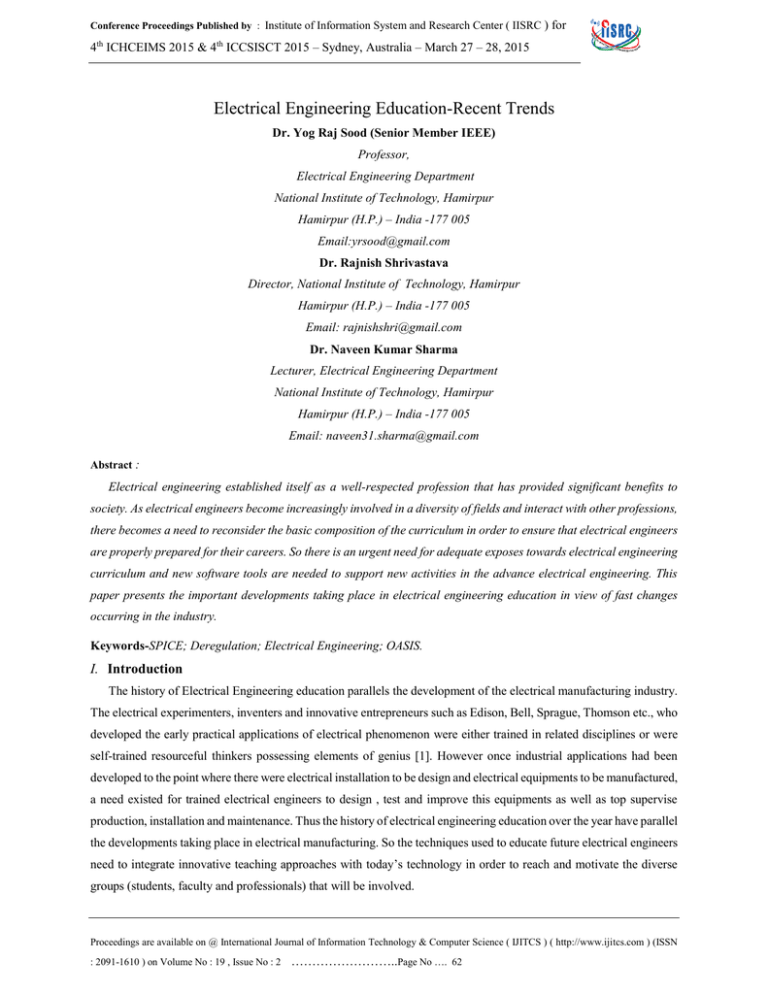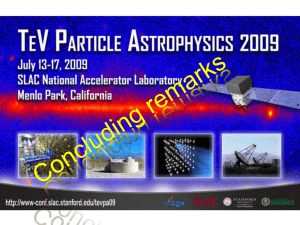Electrical Engineering Education-Recent Trends
advertisement

Conference Proceedings Published by : Institute of Information System and Research Center ( IISRC ) for 4th ICHCEIMS 2015 & 4th ICCSISCT 2015 – Sydney, Australia – March 27 – 28, 2015 Electrical Engineering Education-Recent Trends Dr. Yog Raj Sood (Senior Member IEEE) Professor, Electrical Engineering Department National Institute of Technology, Hamirpur Hamirpur (H.P.) – India -177 005 Email:yrsood@gmail.com Dr. Rajnish Shrivastava Director, National Institute of Technology, Hamirpur Hamirpur (H.P.) – India -177 005 Email: rajnishshri@gmail.com Dr. Naveen Kumar Sharma Lecturer, Electrical Engineering Department National Institute of Technology, Hamirpur Hamirpur (H.P.) – India -177 005 Email: naveen31.sharma@gmail.com Abstract : Electrical engineering established itself as a well-respected profession that has provided significant benefits to society. As electrical engineers become increasingly involved in a diversity of fields and interact with other professions, there becomes a need to reconsider the basic composition of the curriculum in order to ensure that electrical engineers are properly prepared for their careers. So there is an urgent need for adequate exposes towards electrical engineering curriculum and new software tools are needed to support new activities in the advance electrical engineering. This paper presents the important developments taking place in electrical engineering education in view of fast changes occurring in the industry. Keywords-SPICE; Deregulation; Electrical Engineering; OASIS. I. Introduction The history of Electrical Engineering education parallels the development of the electrical manufacturing industry. The electrical experimenters, inventers and innovative entrepreneurs such as Edison, Bell, Sprague, Thomson etc., who developed the early practical applications of electrical phenomenon were either trained in related disciplines or were self-trained resourceful thinkers possessing elements of genius [1]. However once industrial applications had been developed to the point where there were electrical installation to be design and electrical equipments to be manufactured, a need existed for trained electrical engineers to design , test and improve this equipments as well as top supervise production, installation and maintenance. Thus the history of electrical engineering education over the year have parallel the developments taking place in electrical manufacturing. So the techniques used to educate future electrical engineers need to integrate innovative teaching approaches with today’s technology in order to reach and motivate the diverse groups (students, faculty and professionals) that will be involved. Proceedings are available on @ International Journal of Information Technology & Computer Science ( IJITCS ) ( http://www.ijitcs.com ) (ISSN : 2091-1610 ) on Volume No : 19 , Issue No : 2 ……………………..Page No …. 62 Conference Proceedings Published by : Institute of Information System and Research Center ( IISRC ) for 4th ICHCEIMS 2015 & 4th ICCSISCT 2015 – Sydney, Australia – March 27 – 28, 2015 II . Active Teaching Strategies for Electrical Engineering Education Active teaching strategies push students to do more than just listen and take notes. Active teaching methods engage and motivate students to become more involved in their education. So at the end of four years of technical education, students should be proficient in the tools of their trade (analysis strategies, design approaches, simulation methods, measurement techniques) and have the confidence and decision-making ability to determine which tool to apply in a specific situation. Active educational exercises are derived from actual research questions and practical engineering problems [2]. We need to incorporate practical examples and industrially relevant case studies to motivate the students. Electronic media can also help faculty members to meet these needs and integrate analysis, experimentation, visualization and team-based problem solving associated with real-world applications [3]. III . Online Assessment System with Integrated Study (OASIS) Worsening staff-student ratios make it harder to provide adequate assessment and prompt feedback, two quantities important in student learning. Computers and the Internet can provide a solution to this problem. Computers can provide a solution to the dilemma of maintaining an adequate assessment regime in the face of increasing class numbers. When the University of Luton introduced computer-based examinations, an average saving in academic staff time of 50% was immediately noted. In subsequent years there was a further 50% saving [4]. Computers can also provide students with opportunities to practice their skills informally and receive prompt feedback without significantly increasing instructor workload. These opportunities can be made available to students whenever and wherever they have internet access, thus enabling students to learn by trial and error without penalty or loss of face [5]: “the greatest value of computers is that they will watch out for you and let you do stuff without fear of embarrassment” [6]. OASIS is a web-based tool used for skills practice and summative assessment. The tool delivers individualized tasks, marks student responses, supplies prompt feedback, and logs student activity. An action research program has been undertaken in order to develop the software and its implementation in ways that best support student learning [5]. Some instructors reported that the software had helped them manage workloads in spite of rising class sizes and that student learning had been enhanced. Student surveys, interviews, focus-group discussions and informal feedback showed that students found the software easy to use and felt it helped them improve their skills and understanding. Student activity logs provided some interesting insights into study habits and confirmed the motivating power of assessment [7]. IV . Simulation Softwares in Electrical Engineering The simulation software like SPICE, MATLAB, EDSA, Power World etc are of great value to engineering students and instructors, not only in the electrical engineering discipline but also in many other disciplines. When hand calculations become very complicated, sometimes untraceable and time-consuming, or when the experimentation becomes very expensive or time-consuming; as in the case of reliability and availability studies, recourse to computer simulation appears to be inevitable. In such cases, these softwares become an excellent asset to students and instructors. While making use of students’ and instructors’ time much more effectively, it provides a means of predicting the Proceedings are available on @ International Journal of Information Technology & Computer Science ( IJITCS ) ( http://www.ijitcs.com ) (ISSN : 2091-1610 ) on Volume No : 19 , Issue No : 2 ……………………..Page No …. 63 Conference Proceedings Published by : Institute of Information System and Research Center ( IISRC ) for 4th ICHCEIMS 2015 & 4th ICCSISCT 2015 – Sydney, Australia – March 27 – 28, 2015 performance of systems that cannot be constructed in most university laboratories; or, if constructed, it takes a long time to measure their performances. In the design, development, tuning, and upgrading of electrical engineering systems, performance, and reliability are two of the main factors that must be taken into consideration. Whether predicting the behavior of new designs or studying possible changes to existing ones, models of such systems are essential tools for the investigations. Electrical engineering students must, therefore, learn about mathematical evaluation techniques that will help them analyze these models. Of particular interest here is the Markov process model, which is widely used for calculating the reliability and availability of repairable systems. On the other hand, the SPICE circuit simulation program is a general-purpose program that can be used for dc, transient and ac analysis. Recently, the use of SPICE capabilities in studying the behavior of multi-state systems described by Markov models was investigated [10]. SPICE circuit simulation program is an effective tool for calculating the time-dependent probabilities, the system reliability, the system steady-state availability, and the mean time to failure of repairable multi-state systems described by Markov models. This analysis would help instructors and students gain a better insight into the performance of such systems without recourse to complicated procedure required for calculating inverse Laplace transforms of rational fractions in, which involve ratios of two polynomials. Moreover, the use of SPICE would make the use of students’ and instructors’ time much more effective [8]. EDSA Power System Design and Analysis software is world renowned power system analysis software widely used in power utilities electrical heavy industries, oil and gas industries, process industries, shipping and aero-space industries. EDSA software is supplied by EDSA Micro Corporation USA. Power World software is a great help to students and faculty of Electrical Engineering to solve various problems like determination of Load Flow, Optimum Power Flow (OPF) Available Transmission Capability (ATC), etc. related with conventional as well as deregulated power sector with visual approach to analyzing these power system emerging problems. V . LATEST IN ELECTRICAL ENGINEERING EDUCATION Electrical engineers are changing the world. You can witness this impact everywhere, from enormous electrical power grids to nano-machines embedded in living cells. The information and technology revolution has been built-in large part - on the advances of this field. Electrical engineering stands at a time of extraordinary opportunity, as we rise to meet the changing information, communication, transportation, energy, medical, and environmental needs of society. Some latest research involved in this field are SCADA, DSP, Deregulation of Power Sector etc. SCADA - Supervisory Control and Data Acquisition. Due to complex nature of bulk power handling, critical installations like electrical sub-stations are always been closely monitored. Traditionally, this has been achieved by maintain operating & maintenance staff at every Proceedings are available on @ International Journal of Information Technology & Computer Science ( IJITCS ) ( http://www.ijitcs.com ) (ISSN : 2091-1610 ) on Volume No : 19 , Issue No : 2 ……………………..Page No …. 64 Conference Proceedings Published by : Institute of Information System and Research Center ( IISRC ) for 4th ICHCEIMS 2015 & 4th ICCSISCT 2015 – Sydney, Australia – March 27 – 28, 2015 substation. However, with increasing number of sub-station & pressure to decrease operational expenses it is no longer possible to man every new substation. On the other hand at the data gathered in the sub-stations is gaining strategic importance in planning & operations. In such situation therefore, it is desirable to have quick data acquisition and instant response to any event, with minimum human intervention. The concept of SCADA is ideally suited for such situations [9]. Deregulation Deregulation is a relatively recent concept, whose economic, regulatory and implementation structure continues to be adopted to the specific needs of each nation. For example, price based unit commitment and optimal power flow solutions with bidding generations and loads characteristics in the present scenario is totally different compared to a regulated set up. However, the demographics of power generation, transmission, and distribution are changing dramatically in both the operating and business sector of the electric utility industry due to deregulation of power industry. The main objective of the deregulated power sector market is to decrease the cost of electricity through competition. The market environment typically consists of a pool and privately negotiated contracts. The performance of a market is measured by its social welfare, also called social benefit (SB). Social benefit is the difference of society’s willingness to pay for energy and its cost [10]. Conclusion Today, computers influence almost every aspect of our work and have pervasively invaded the home as well. Yet with all this computing power available, we still have only begun to scratch the surface of how we may harness technology to improve electrical engineering education. So the electrical engineering educators are required to upgrade the electrical engineering education curriculum parallel with advancement of the structure of power industry so that, the outgoing students and researchers can face the challenges with modern deregulated power industries. REFERENCES 1. Terman, F.E, “A Brief History Of Electrical Engineering Education”, Proceedings of the IEEE, Volume 86, Issue 8, Aug. 1998 Page(s):1792 – 1800. 2. Bernhard, J.T, “Challenges and strategies for electrical engineering education”, Frontiers in Education Conference, 1997. 27th Annual Conference. 'Teaching and Learning in an Era of Change'. Proceedings, Volume 3, 5-8 Nov. 1997 Page(s):1459 – 1462. 3. Millard, D.; Burnham, G, “Innovative interactive media for electrical engineering education”, Frontiers in Education Conference, 2001. 31st Annual, Volume 3, 10-13 Oct. 2001 Page(s):S3C - 17-22. 4. S. Zakrzewski and J. Bull, "The mass implementation and evaluation of computer-based assessments," Assessment & Evaluation in Higher Education, vol. 23, pp. 141-152, 1998. 5. A. Deeks, "Web-based assignments in structural analysis," presented at Australasian Association for Engineering Education 11th Annual Conference, Adelaide, Australia, 1999. Proceedings are available on @ International Journal of Information Technology & Computer Science ( IJITCS ) ( http://www.ijitcs.com ) (ISSN : 2091-1610 ) on Volume No : 19 , Issue No : 2 ……………………..Page No …. 65 Conference Proceedings Published by : Institute of Information System and Research Center ( IISRC ) for 4th ICHCEIMS 2015 & 4th ICCSISCT 2015 – Sydney, Australia – March 27 – 28, 2015 6. A. Reinhardt, "New ways to learn," in Byte, The Magazine of Technology Integration, vol. 20, 1995, pp. 50-72. 7. Smaill, C, “The Implementation and Evaluation of OASIS, a Web-Based Learning and Assessment Tool in Electrical Engineering”, Frontiers in Education Conference, 36th Annual, Oct. 2006 Page(s):1 – 6. 8. Abuelma'atti, M.T.; Qamber, I.S, “Applications of SPICE simulation software to the study of reliability and availability in electrical engineering education”, IEEE Transactions on Education, Volume 45, Issue 3, Aug. 2002 Page(s):209 – 217. 9. http://www.ashidaelectronics.com/scada.htm 10. Padhy, N.P.; Sood, Y.R, “Advancement in power system engineering education and research with power industry moving towards deregulation”, Power Engineering Society General Meeting, 2004. IEEE, 6-10 June 2004 Page(s):71 - 76 Vol.1. Proceedings are available on @ International Journal of Information Technology & Computer Science ( IJITCS ) ( http://www.ijitcs.com ) (ISSN : 2091-1610 ) on Volume No : 19 , Issue No : 2 ……………………..Page No …. 66

